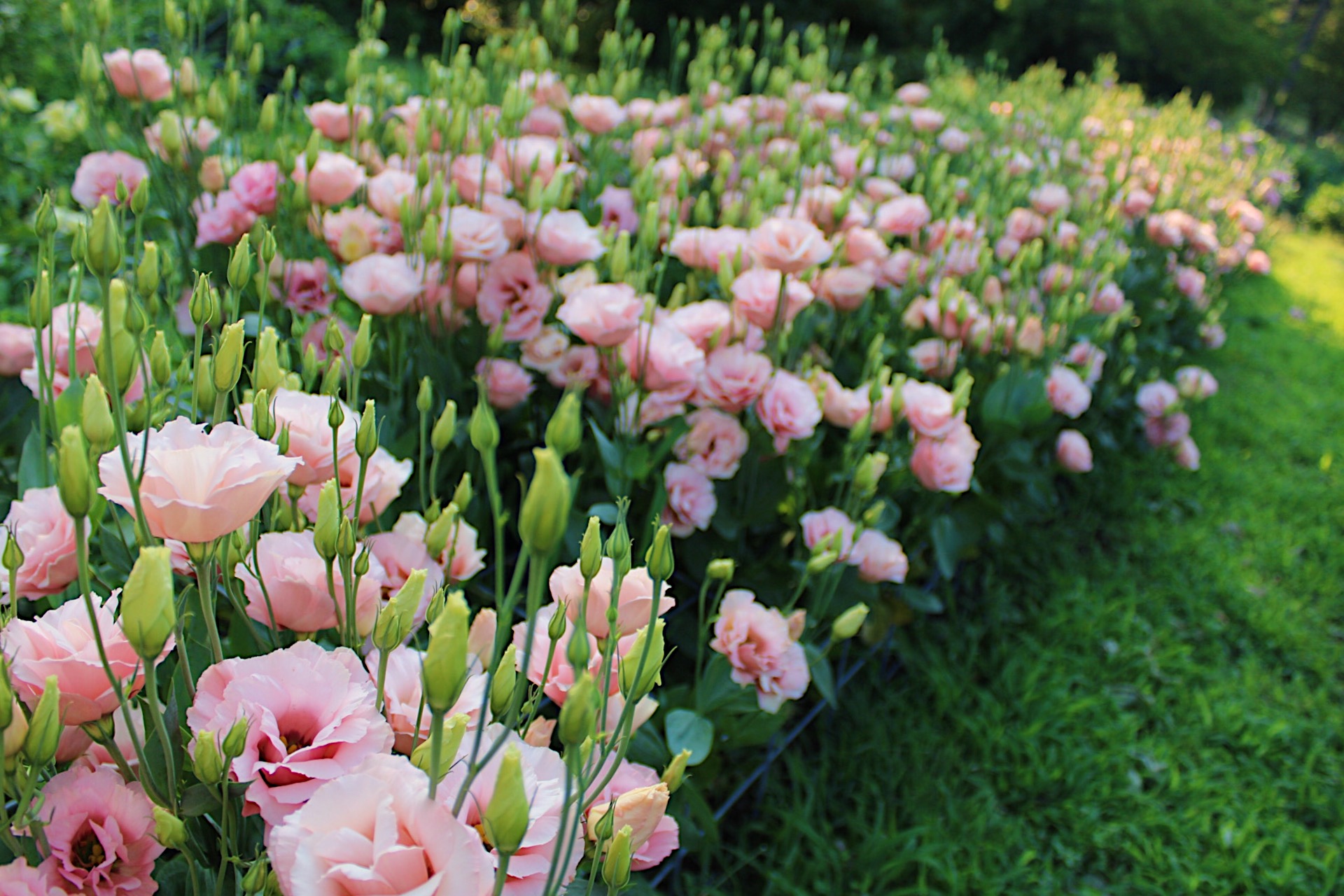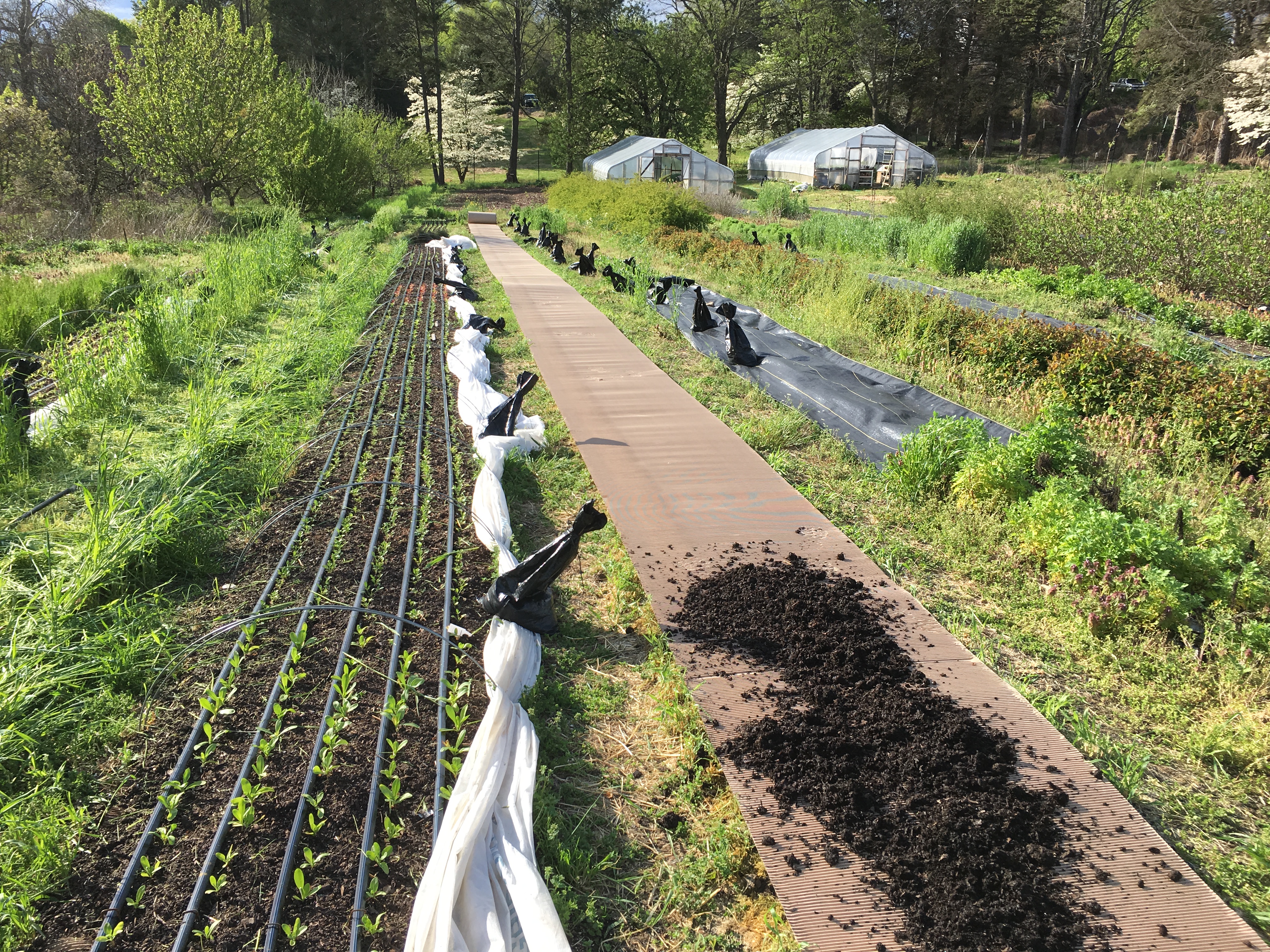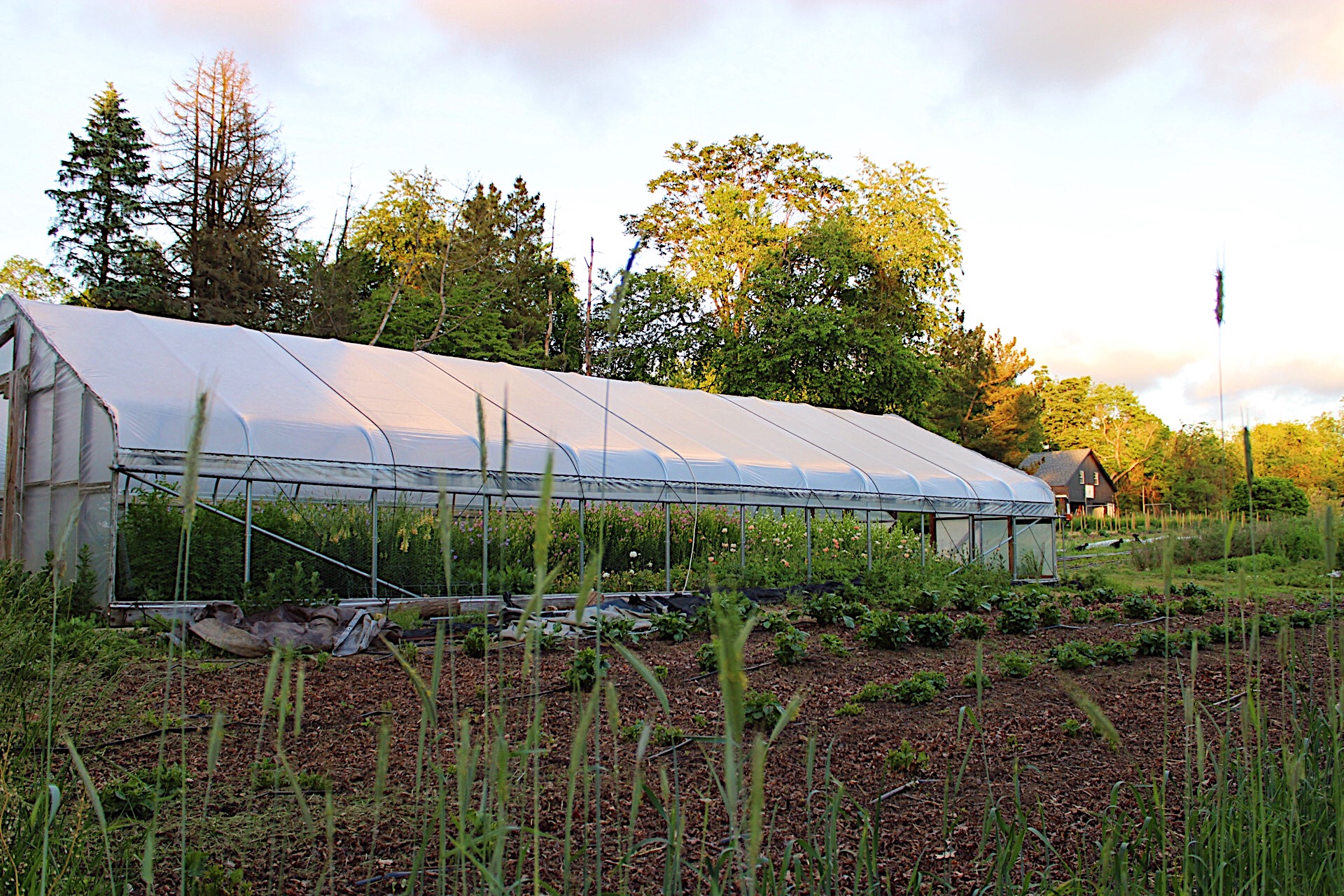No-Till Flowers: A Podcast for Flower Farmers
No-Till Flowers is a brand new podcast for flower farmers launching next week on Wednesday, December 23rd! I’ve been writing about no-till/regenerative/organic flower farming here on the blog for many years now. Over the summer in 2020, Farmer Jesse at No-Till Growers Podcast (my fav podcast!) interviewed me on the subject of living pathways. From that fun conversation stemmed this idea that maybe a no-till podcast for flowers farmer specifically would be a great niche to fill. Farmer Jesse asked me if I’d like to take on the project under the umbrella of No-Till Growers, to which I immediately said “Yes!”.

In the grand scheme of things, I’m a relative babe in the woods when it comes to no-till farming. I first started using no-till systems in 2018 out of desperation and with only a little hurried research. Since then I’ve been consuming as much information as possible through books, podcasts, and regenerative ag conferences. And I’ve been experimenting a lot and making observations at my farm over the past three growing seasons to see what’s working and what’s not.
I still have a lot of questions though! Any good farmer keeps a sense of wonder, curiosity and frank skepticism throughout their years of growing in order to adapt to the constant change that is involved in nurturing crops and soil. I think I’d be really freaked out if I came to a point in my farming journey where I thought I had all the answers and had mastered all the moving parts!! In reality, I’ve made a lot of blunders in my farming career and didn’t dig into a particular topic/approach enough before I implemented it. Because I have so many questions still in particular about no-till and regenerative practices, a podcast for flower farmers seemed like a great avenue for asking my questions in a format that can be recorded and shared with other curious souls.

So what topics is this new podcast for flower farmers going to cover? Well, it’s definitely not just about no-till methods. For instance, during one episode I get giddy with Tony at Bare Mountain Farm about Korean Natural Farming (KNF) and JADAM applications. In another episode, I have a fun with Laura Beth from Butterbee Farm about compliment sandwiches served up while managing her farm crew. Mimo Davis from Urban Buds and I talk about reclaiming urban lots for growing flowers. I ask farm coach extraordinaire Ellen Polishuk why she dislikes that small scale growers have adopted the term “no-till” so enthusiastically, given its historical context in Big Ag. There’ll also be conversations with other guests through the season about growing in windy locations with sandy soil; keeping your spirits and soil up during severe multi-year drought, how biodynamics can be used on flower crops, planting with the moon cycles, no-till growing in super cold zones, and much more!
Make sure to tune in! And please leave me your no-till and other regenerative farming questions below so I can try to incorporate them in this podcast for flower farmers! I want to get YOUR questions answered too!


Excited for this! 🙂
Thanks, Annie! 🙂
I am SO over the moon about this podcast. Exactly the resource I was looking for. THANK YOU X 10000000.
Awesome to hear, Mari!!
Thank you for this amazing resource. Can’t wait to dig in. One burning question I have is how to break ground using a low-till method. I have a field previously used for grazing pigs, made of grass with some perennial weeds. My thought is either to use a BCS with the plow attachment to break through the grass and upturn the soil as a ‘one time’ measure, or to lay down tarps to kill the grass. The latter option I struggle with as I don’t want to buy/use plastic as much as possible. Is there a way to avoid using plastic, or tilling one-time to get started?? Thank you Jennie!!
Either of your approaches would work, Marie. I do have a couple podcast episodes that will air in early January that discuss breaking new ground so be sure to listen to those. There are different schools of thought. Some people think that getting one pass of tillage over new ground is really important to getting going, especially if you need to work in amendments and/or adjust the pH. Other folks swear by tarps as the best approach. On my own farm, all my planting area was tilled at least once in the beginning. But I also use tarps a lot to terminate cover crops and/or persistent perennial weeds. My tarps are recycled billboards that last for about 10 years so I feel fairly okay with knowing I’m taking plastic out of the landfills for awhile at least by giving these billboards a second life and they don’t rip like the silage tarps that many farmers use. But you’ll have to decide for yourself what makes the most sense for your farm. Like everything in farming, no-till needs to be tailored to your own situation. There’s no prescribed “this always is the best way” method. Good luck!
I’m a newbie to organic urban gardener. One good thing that came out of COVID was that I could spend more time at home learning about my garden (2nd year as a homeowner). I’m at the beginning of my journey and I’m so excited to tune in! I’ll be moving to another city soon where I’ll get more rainfall and I’m looking forward to more favorable growing conditions. Woohoo!
I’m hoping that you will be interviewing farmers from different regions of the US, including central Texas or gulf coast Texas, and it would be interesting to hear from people with academic backgrounds talk about the scientific methods, like companion planting (I just ordered Jessica Walliser’s book called Plant Partners and I’m sure it’ll be very enlightening), which I think would be really helpful in addition to anecdotal evidence.
Is your podcast going to be separate from the No-Till Garden one? I heard your episode on his “channel” but I wasn’t sure if it was just me that couldn’t find a separate one for yours (in the Google Podcast library). Thanks!
Thanks for the comment, Christina! I’ll look into the book you mentioned and will hopefully have more guests on about companion planting. The No-Till Flowers Podcast is separate from from Jesse’s No-Till Market Garden podcast. Not sure about Google, but you can find it here:
https://podcasts.apple.com/gb/podcast/the-no-till-flowers-podcast/id1545850888
or here:
https://notillflowers.libsyn.com/
Happy listening! 🙂
This is the best gift to flower growers!! I can’t wait to listen to them all! I would love to hear more about interplantings. I was trying to use companion planting methods when I started out with vegetables and then when I moved on to flowers I didn’t see where it fit in until you explained some of your experiments with direct seeding a second crop into planted beds or using red radishes under slower growing crops. This concept has me moving away from landscape fabric. While I’m nervous about weed pressure, I’m excited by the possibilities. Thanks for all you do!
I would love to learn more from your pod cast but to be honest have no clue how to do so… never done a podcast .. how do I participstw
A podcast is basically an internet-based radio show. All you have to do is click on this link and you can see each episode and then click “play” for any of them to listen to that particular show where I interview a guest. Hope that makes sense! Happy listening!
Jennie- Thank you for all of your wonderful podcasts- I have just discovered them and have been following closely. I am seriously considering moving away from using landscape cloth to living pahways/ no-till this next season. I’m not sure if this is the place to leave these questions but…1. Is there a cover crop that I could plant now or early spring that would have a chance of taking? I’m in Pittsburgh, PA. And 2. what do you do to manage voles or other pests in your rows? I planted 2000+ anemones and ranunculus this fall and covered them in low tunnels- and basically created a haven for the voles. The crop is destroyed! Any advice/ suggestions would be welcome. Thank you!
Glad to hear the podcast is proving helpful, Becca! To answer your questions, there aren’t any cover crops that you could sow now in January in Pittsburgh that will germinate in the deep cold of winter. In the spring, you could put in a quick crop of mustards or tillage radish (sow sometime in March) or if you want to get clover started in your pathways, sow that seed in March as well. Regarding voles, my best advice is to get some farm cats. No indoor pet cats, but outdoor, semi-wild cats. I have two tom cats that live at my farm and as a result, I have zero issues with voles or mice. If you can’t have cats, then you’ll have to put out a lot of traps. Eliot Coleman has a clever box trap, which you should be able to find via Google. That’s so frustrating that voles ruined your anemones and ranunculus!!! Ugh!
So great to listen to your podcast! I’m in the process of turning our small backyard in the neighborhood to a flower cut flower garden for my own enjoyment and to share flowers to others(hopefully I can grow something). I have placed cardboard and mulched leaves(no till as we have clay soil), learning to start seeds and probably over ordered seeds and spring bulbs/tubers to plant to what space I have. I’m starting slow. Thanks for the all the info.
Starting slow is definitely the way to go! Enjoy your time tending the flowers and all the joy they’ll bring to you and your neighbors!
Thank you so much for creating this podcast Jennie – finally got a chance to take a listen and the stack of burning questions that have been piling up in my head about no-till and flowers are getting picked off one after the other, it’s so cathartic and satisfying! And thanks for encouraging hosts to bring the mistakes into the open and dissect them, takes the curse off as well as gives the rest of us hope we don’t have to be perfectionists :-). I have a specific question – you mentioned on your wedding flowers training (taking that too 🙂 ) that you have perennialized your dusty miller bed to get woody stems sooner. I’m trying that for the second time this winter, it’s in one of my tunnels here in Pacific Northwest zone 7b. I want to clean out old leaves as much as possible to control the funguses I battle in the tunnels. If I prune it all back, including the central growing points, am I shooting myself in the foot as far as getting early season woody stems? Any insights much appreciated!
Glad to hear it, Betsy! The podcast has been super fun to produce!
Regarding the dusty miller, I usually prune my pretty heavily after Thanksgiving, but leave any growing tips that look like they’ll keep pushing out healthy shoots. Then over the winter the plants kind of hunker down, but because they have a robust perennial root system, in the spring they shoot up fast and get sturdy stems much sooner than they would out in the field or as an annual. So for you right now, I’d say clean off any and all questionable leaves but let any decent looking shoots in place. Oh, and for what it’s worth, I only grow ‘New Look’. Hope that helps!
Hi Jennie,
I’m really enjoying this podcast. Heard you talking about dahlias yesterday & you mentioned how beneficial foliar feeding is. Just wondering what product you use as I’ve had trouble with organic products gumming up my sprayer.
I use a homemade blend of Korean Natural Farming (KNF) inputs in addition to kelp, fish emulsion, and other ingredients according to what the crop needs at that stage of growth. The podcast episode with Tony from Bare Mountain would be a good listen for you if you haven’t already. And I’ll be writing more blog posts about what inputs I use at the farm (applied via foliar feeding). So stay tuned. 🙂
I would love to learn flower farming….
I am so excited to find this! I am at the beginning stages of wanting to start a flower farm! Thank you so much for taking the time to educate us budding farmers!
Thank you Jennie for gathering and sharing all this wonderful information! There is just so much to know and discover toward the beautiful goal of a holistically managed stable farm ecosystem! I am excited to add some wren houses to my dahlia patch this spring 🙂
Wonderful, Renee! I’m excited for you to have the joy and energy of wrens around you. They really are such wonderful birds! 🙂
Hi Jenny,
Just saw you were doing this. Started my farm in 2013 and have been no till since 2015~ way to spread the word! Let me know if you ever have any guest needs, I’d love to be on it! Thanks!
Just Discovered the podcast!!! Thanks for all the great information. I’m sure I’ll have questions later on. Been Urban Gardening for a number of years and am in the process of buying some Property!!
Hi Jennie,
How do you irrigate your living pathways?
Hi Jenny! I am a little late to the party but have committed to start a micro flower farm in Newark, DE and your podcasts are my north star for a wealth of information! I hope there are more to come as I have so much to learn, please keep ’em coming!